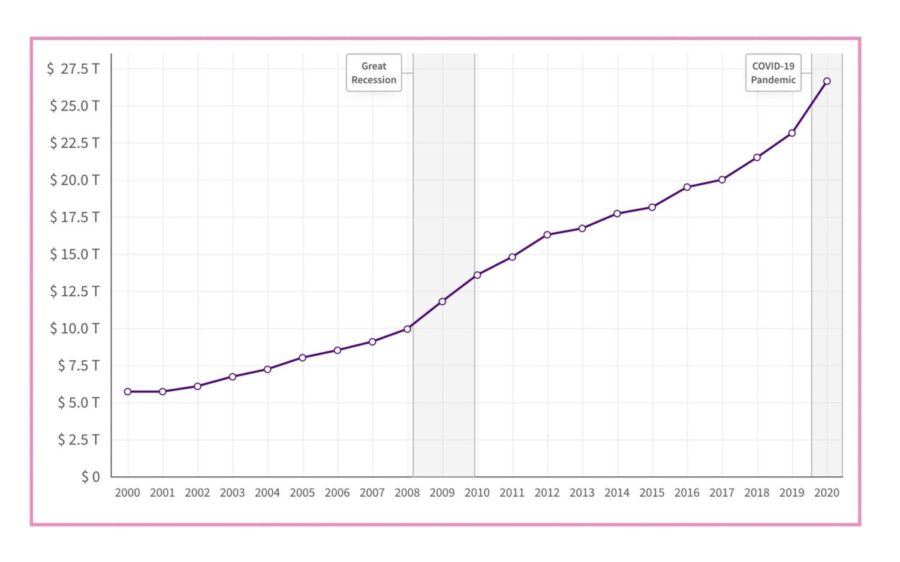Abolish the Federal Debt Ceiling
Every couple of years, the US is threatened by a political crisis unlike any other. It doesn’t usually grab headlines, nor is it particularly interesting, but it is nevertheless vital to both American and world economies as well as the United States’ international standing. This crisis is the congressional fight over whether or not to raise the debt ceiling.
The debt ceiling, which was established as an artificial check against the Federal government’s spending power, limits how much the US can pay off its debts. The reason for which it was originally established is legitimate, and since its inception, Congress has raised the debt ceiling numerous times whenever it became necessary. In the past 20 years, however, both Democrats and Republicans alike have used the debt ceiling – specifically the threat of not raising it – as a political cudgel with which to advance their political agendas. This is an extremely dangerous tactic and it could spell catastrophe for millions of Americans. To reiterate, there is nothing about the debt ceiling’s continued existence that is necessitated by reality. It is a threat to both the American economy and the American people, and it must be removed before it can exact cataclysmic damage on the standing of the US on the world stage.
In the past, deciding whether to pay off the debt or fund the government was a relatively bureaucratic process. After all, no sane American politician wanted to be responsible for sinking the American economy. This status quo changed in the 1990s, when Newt Gingrich, then the Republican Speaker of the House, shut down the Federal government over Bill Clinton’s spending policies. During the 2000s, congressional Democrats used the debt ceiling as a bargaining chip to attempt to get George Bush to scale back the war in Iraq. In 2011, congressional Republicans used the debt ceiling to oppose the Affordable Care Act and Obama’s broader domestic policy. This debt ceiling standoff led to the downgrading of the United States’ credit rating for the first time, and showed that the US did not even need to exceed the debt limit to face dire consequences.
But what would the consequences even be if the debt ceiling was broken? As mentioned previously, if the debt limit were reached, the US would be legally unable to pay back its loans. This handicap would result in the US defaulting on its debt for the first time ever, causing our interest rates to soar and making it inordinately hard for the US to borrow money in the future. In addition, social security payments and military paychecks would cease. Obviously, this would be catastrophic and would most likely send the US, as well as the world, into yet another recession. Such a disaster must be avoided at all costs, and yet the debt ceiling continues to exist despite being the only reason for a possible default. There are two reasons why the debt limit is still in place.
First, there are people who genuinely believe that the debt limit acts as a check on government spending. This idea is completely wrong. The debt ceiling acts neither as a check on federal spending itself nor as a deterrent when it comes to passing tax cuts or a budget. Politicians love to throw the national debt around as a political football whenever they’re in the minority, but whenever they have the power to pass legislation, most politicians will raise spending and cut revenue. Even if that weren’t the case, however, the debt limit does not act as a check on spending. The debt limit doesn’t place restrictions on how much can be spent, it places restrictions on how much money we are allowed to pay back to our creditors. In this sense, the debt limit is not so much a budget of how much we’re allowed to spend, but a restriction on how much of the nation’s figurative credit card bill we’re allowed to pay.
The second reason is, of course, politics. Congressional Republicans are claiming that their refusal to raise the debt ceiling is due to Biden’s irresponsible spending policies. Regardless of what one might think of Biden’s policies, the truth is that the current president is only responsible for 3% of the country’s outstanding debt (that is, debt that needs to be paid that will go over the debt limit). In fact, much of the outstanding debt is a direct result of Trump-era policies, including the 2017 tax cuts that most of the current Congressional Republicans voted for. In the end, though, this doesn’t matter. Republicans are hoping that by forcing the Democrats to raise the debt ceiling on their own using reconciliation (a time-consuming process that is only supposed to happen once a year), they will have ammunition to use against Democratic candidates in the 2022 midterms. The Democrats are not innocent either: both parties have a history of using debt limit threats as a way to force the majority party to make concessions in their agenda.
The use of the debt ceiling as a political bargaining chip has had mixed results, but thus far the US has never defaulted on its debt. Congress recently passed a stopgap measure to add about half a trillion dollars to the debt ceiling, which will push the issue off until December. Regardless of how this clash over the debt limit pans out, the fact remains that the debt ceiling is a ticking time bomb. The health and well-being of the American people, not to mention the global economy, are in jeopardy for as long as the debt limit exists, and the dangers of defaulting are far too great to be used as political threats. Moreover, the continued existence of the debt limit does not provide any tangible benefit to either political discourse or the country. It is clear that Congress must abolish the debt ceiling as soon as possible, and avoid the political theater.






